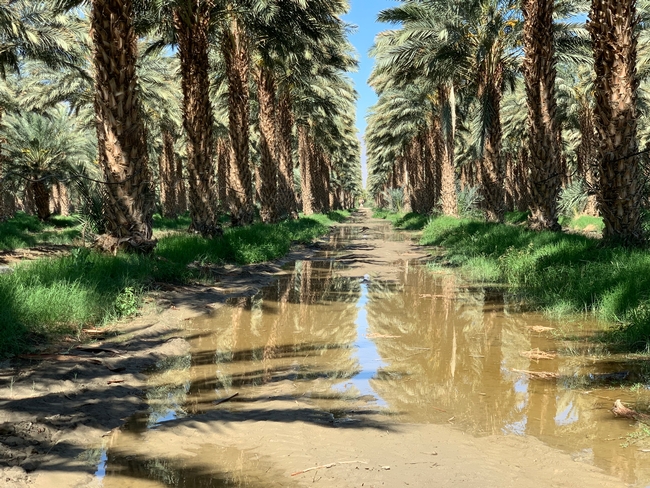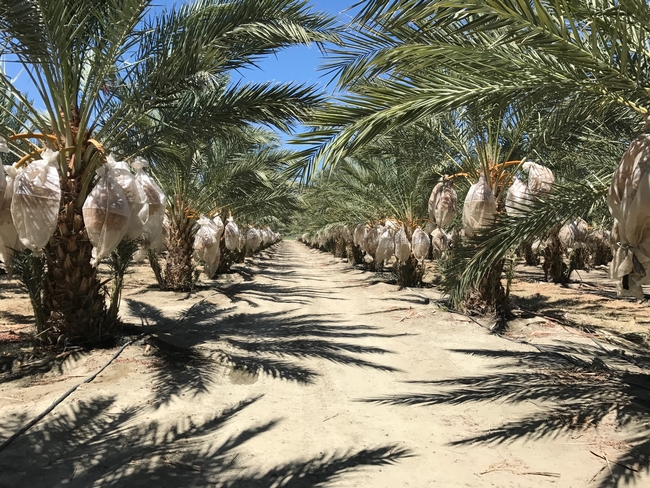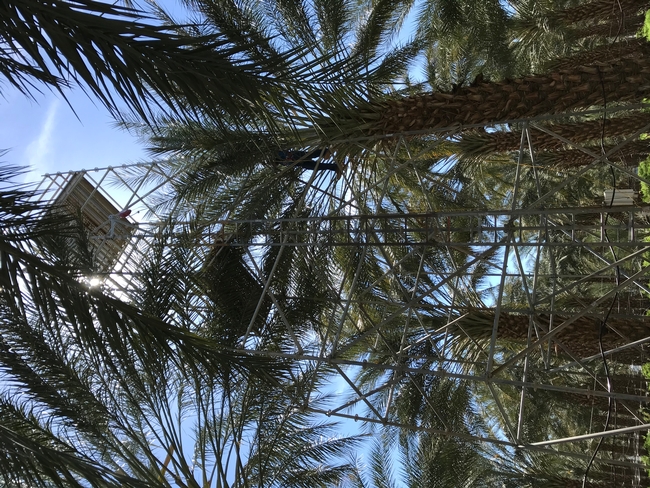Historically, date palms are grown along riverbeds or in areas with groundwater because they require an abundance of water to produce a good crop. Unlike lettuce or table grapes, date palms are deceptive in that they do not immediately wilt if underwatered. Eventually, however, the lack of water hurts yields and fruit quality.
The default for date growers is to apply excessive water, but doing so is neither economically nor environmentally sound. To help growers, Ali Montazar, UC Cooperative Extension irrigation and water management advisor for Imperial, Riverside and San Diego counties, has developed knowledge that enables growers in the region to establish irrigation guidelines they can use with confidence.
“Water issues in California's desert are very different than in the Central Valley,” said Montazar. “There is no groundwater to recharge so growers in the desert only have the Colorado River.”
Since 2019, Montazar has been focused on irrigation management for date palms in the Coachella Valley, the largest producer of dates in the United States. Montazar's research identifies how much water is needed for the crop and the best water delivery method according to location, soil type and conditions, and date cultivars.
“Dates require a lot of heat and light, which is why they do well in the desert. But they also need a fair amount of irrigation,” said Robert Krueger, a U.S. Department of Agriculture horticulturist and Montazar's co-author of a paper on date palm irrigation management.
Much of what we know about date palm production comes from the Middle East, which has a climate similar to the low desert of California. “That information is from many, many years ago though,” explained Montazar, whose research shows that drip irrigation cannot be the only form of irrigation for date palms.
“Ali is the first to really look at micro-sprinklers and flood irrigation for date palms,” said Krueger, adding that the other advantage of Montazar's research is that it prepares growers for production during times of reduced water supply.
Albert Keck, president of Hadley Date Gardens, Inc. and chairman of the California Date Commission, described Montazar's research efforts as “subtle yet incredible and profound,” adding that his findings not only benefit other farmers but also cities relying on water from the Colorado River.
Keck, one of the largest date growers in California, is well aware of how disruptive, expensive and time-consuming irrigation for date palms can be. Montazar has enabled growers like Keck to irrigate less without sacrificing yield or quality.
“Ali might save us a tiny percentage of the amount of water we're using. It might be a 5 or 10% savings. It doesn't seem like much, but it's an incremental improvement in efficiency,” said Keck. “And if you add all of these improvements up, say, along the U.S. Southwest, then that has a pretty profound impact.”
Montazar recommends that date growers in his region use a combination of drip and two to three flood irrigation events to manage salinity levels derived from the Colorado River. “We cannot maintain salinity issues over time if we're only relying on drip irrigation in date palms,” explained Montazar.
Flood irrigation pushes the salts below the root zone, when they would otherwise build up within the root zone preventing efficient water uptake. It also aids in refilling soil profiles quickly and more effectively since drip has a lower capacity of delivering sufficient water.
“Growers know what they need to water their crop within a broader parameter. But Ali has narrowed that window and helped us become more precise with our irrigation,” Keck said. “There's still room for improvement but we're spending less money, wasting less time and using less water now, and we're still getting the same positive results.”
Currently,Montazar is collaborating with the California Date Commission on developing guidelines for best irrigation management practices in the desert for date palms, which should be available by the end of 2023. These guidelines are based on a four-year data set from six monitoring stations and extensive soil and plant samples from commercial fields located in theCoachella Valley, Imperial Valley and near Yuma, Arizona. Additionally, Montazar is working to quantify how water conservation impacts growers economically.
“Growers from United Arab Emirates, Egypt, Tunisia and Mexico have already reached out asking for this information,” Montazar said, while reflecting on a presentation he made to a group of international date growers in Mexico late last year.
To read the paper on date palm irrigation, published in MDPI's Water journal, visit: https://www.mdpi.com/2073-4441/12/8/2253.


